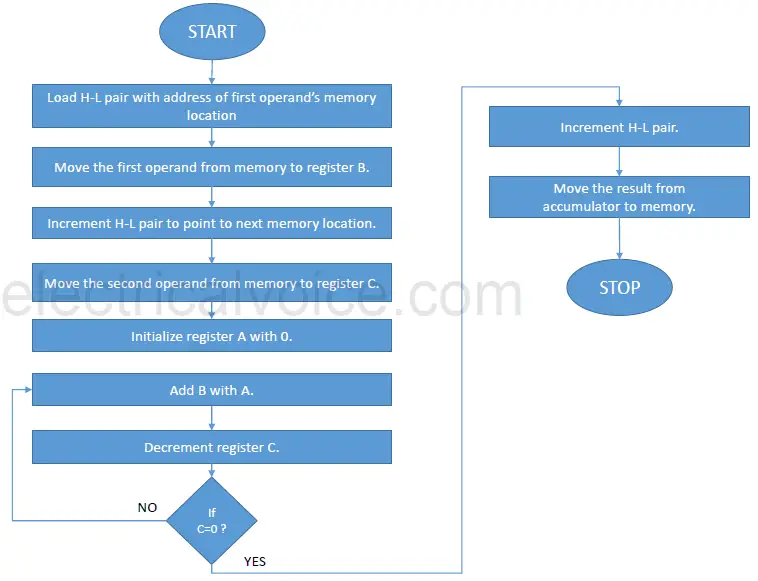Q. Write an 8085 program and draw a flowchart to Multiply two 8-bit numbers.(8085 Microprocessor Program)
Flowchart/Algorithm

Program
| Address | Mnemonics | Operand | Opcode | Comments |
| 2000 | LXI | H, 3000H | 21 | Load H-L pair with address 3000H. |
| 2001 | 00 | |||
| 2002 | 30 | |||
| 2003 | MOV | B, M | 46 | Move the 1st operand from memory to reg. B. |
| 2004 | INX | H | 23 | Increment H-L pair. |
| 2005 | MOV | C, M | 4E | Move the 2nd operand from memory to reg. C. |
| 2006 | MVI | A, 00H | 3E | Initialize accumulator with 00H. |
| 2007 | 00 | |||
| 2008 | ADD | B | 80 | Add B with A. |
| 2009 | DCR | C | 0D | Decrement reg. C (counter). |
| 200A | JNZ | 2008H | C2 | Jump back to address 2008H if C ^ 0. |
| 200B | 08 | |||
| 200C | 20 | |||
| 200D | INX | H | 23 | Increment H-L pair. |
| 200E | MOV | M, A | 77 | Move the result from accumulator to memory. |
| 200F | HLT | 76 | Halt |
Output
Before Execution:
3000H: 02H
3001H: 05H
After Execution:
3002H: 0AH
Program Explanation
- This program multiplies two operands stored in memory location 3000H and 3001H, using successive addition method.
- In successive addition method, the second operand is considered as the counter, and the first number is added to itself until counter decrements to zero.
- Let us assume that the operands stored at memory location 3000H are 02H and 3001H is 05H.
- Then, by using successive addition method, we get 02H + 02H + 02H + 02H + 02H = 0AH.
- Initially, H-L pair is loaded with the address of first memory location.
- The first operand is moved to register B from memory location 3000H and H-L pair is incremented to point to next memory location.
- The second operand is moved to register C from memory location 3001H to act as the counter.
- The accumulator is initialized to 00H.
- Register B is added to the accumulator and the result is stored in the accumulator.
- Register C (counter) is decremented by 1.
- Then, the counter is checked for zero. If it hasn’t become zero yet, then register B is again added to the accumulator, and the counter is again checked for zero.
- If counter becomes zero, then H-L pair is incremented and the result is moved from the accumulator to memory location 3002H.

Great tutorial! I found the step-by-step explanation really helpful, especially the inclusion of code snippets. It’s clear and easy to follow for anyone looking to understand 8-bit multiplication in assembly. Thanks for sharing!
Great post! The step-by-step explanation of multiplying 8-bit numbers was really helpful. I appreciate the examples provided, as they made the concept much clearer. Looking forward to more informative articles like this!
Great post! The step-by-step explanation of multiplying two 8-bit numbers was really helpful. I appreciate the clear examples and the diagrams. Keep up the good work!
Great post! The step-by-step explanation of multiplying two 8-bit numbers was very clear and easy to follow. I appreciate the sample code you provided—it’s always helpful to see how the theory translates into practice. Looking forward to more articles like this!
This is a fantastic post! The detailed explanation and clear examples made it much easier to understand how to multiply two 8-bit numbers. I especially appreciated the step-by-step approach. Thanks for sharing such valuable insights!
This is a great post! The explanation of the algorithm was really clear, and the code snippets were helpful for understanding how to implement the multiplication of 8-bit numbers. I appreciate the attention to detail in outlining potential edge cases as well. Keep up the good work!
Great explanation! The step-by-step breakdown of multiplying two 8-bit numbers made it easy to follow along. I appreciate the clear examples and the visuals you provided. Looking forward to more posts like this!
Great post! The detailed explanation and step-by-step approach to multiplying two 8-bit numbers is really helpful. I appreciate the clear examples and the code snippets you provided. Looking forward to applying this in my projects!
Great post! The explanation of multiplying 8-bit numbers was clear and easy to follow. I especially appreciated the step-by-step breakdown of the algorithm. Looking forward to more content like this!